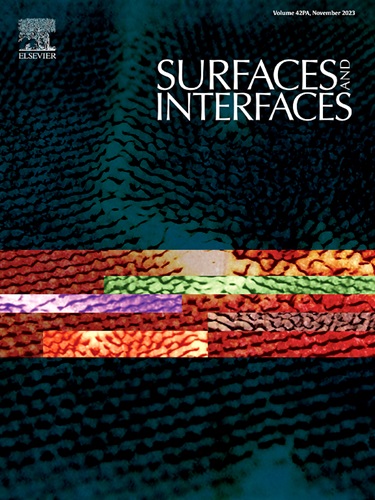Anti-corrosion property and failure mechanism of the EPN coating under the harsh desulfurized flue gas corrosion environment: Experimental research and artificial neural networks analysis
IF 5.7
2区 材料科学
Q2 CHEMISTRY, PHYSICAL
引用次数: 0
Abstract
Novolac epoxy coating (EPN) has excellent anti-corrosion properties. However, the protective performance will still decline in harsh desulfurized flue gas environments. The primary factors leading to the failure of EPN coating and the influence degree of each factor have not been thoroughly studied. In this paper, the anti-corrosion properties and failure mechanism of EPN coating in harsh desulfurized flue gas environments are studied based on experimental and artificial neural networks (ANN) analysis. The experimental results demonstrated the anti-corrosion properties of EPN coating are significantly influenced by 10 wt% H2SO4 solution at 55 °C and cold-thermal shock at -60 – 140 °C. However, the sulfuric acid vapor environment with a pH of 0.2 – 0.5 at 55 °C has little effect on the corrosion protection performance of the EPN coating. Maybe the main reason is that the amine bond (C-N) in the EPN coatings is easily induced by acid-induced hydrolysis and the EPN coating is a brittle material and prone to brittle cracking due to alternating hot and cold. In addition, the contribution of each influencing factor to the failure of EPN coating is obtained by experiment and artificial neural networks: Sulfuric acid solution > Cold-thermal shock > Sulfuric acid vapor. The influence degree of each factor on EPN coating failure: sulfuric acid solution (RCC = -0.7212, SRRC = -0.7009), cold-thermal shock (RCC = -0.6606, SRRC = -0.588), and sulfuric acid vapor (RCC = -0.0249, SRRC = -0.0281). The research results provide theoretical guidance for the coating design using heat exchangers in harsh desulfurized flue gas environments.

脱硫烟气腐蚀环境下EPN涂层防腐性能及失效机理:实验研究与人工神经网络分析
新型环氧涂料(EPN)具有优良的防腐性能。但在恶劣的脱硫烟气环境中,防护性能仍会下降。导致EPN涂层失效的主要因素及各因素的影响程度尚未得到深入的研究。本文基于实验和人工神经网络(ANN)分析,研究了EPN涂层在恶劣脱硫烟气环境下的防腐性能及失效机理。实验结果表明,10 wt% H2SO4溶液(55℃)和-60 ~ 140℃冷热冲击对EPN涂层的防腐性能有显著影响。而55℃下pH为0.2 ~ 0.5的硫酸蒸气环境对EPN涂层的防腐性能影响不大。主要原因可能是EPN涂层中的胺键(C-N)容易被酸诱导水解,EPN涂层属于脆性材料,在冷热交替下容易发生脆性开裂。此外,通过实验和人工神经网络得到了各影响因素对EPN涂层失效的贡献:硫酸溶液;冷热冲击>;硫酸蒸气。各因素对EPN涂层失效的影响程度分别为:硫酸溶液(RCC = -0.7212, SRRC = -0.7009)、冷热冲击(RCC = -0.6606, SRRC = -0.588)、硫酸蒸汽(RCC = -0.0249, SRRC = -0.0281)。研究结果为恶劣脱硫烟气环境下换热器涂层设计提供了理论指导。
本文章由计算机程序翻译,如有差异,请以英文原文为准。
求助全文
约1分钟内获得全文
求助全文
来源期刊

Surfaces and Interfaces
Chemistry-General Chemistry
CiteScore
8.50
自引率
6.50%
发文量
753
审稿时长
35 days
期刊介绍:
The aim of the journal is to provide a respectful outlet for ''sound science'' papers in all research areas on surfaces and interfaces. We define sound science papers as papers that describe new and well-executed research, but that do not necessarily provide brand new insights or are merely a description of research results.
Surfaces and Interfaces publishes research papers in all fields of surface science which may not always find the right home on first submission to our Elsevier sister journals (Applied Surface, Surface and Coatings Technology, Thin Solid Films)
 求助内容:
求助内容: 应助结果提醒方式:
应助结果提醒方式:


